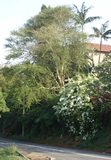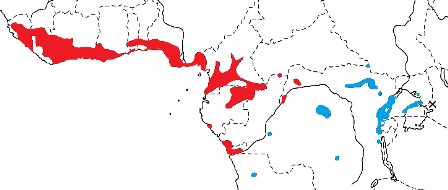Weaver species
Choose different species from drop-down list and press 'Go' button. See Full species list.Yellow-mantled Weaver Ploceus tricolor
IUCN: Least concern Discovery: 058Categories: fruit, Gymnogene, nectar, blue eggs, palm,
News items about species
Discovery
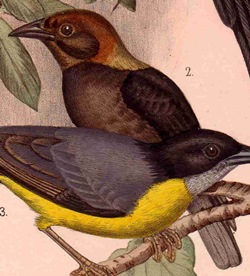
figure from Reichenow (1902) (Dark-backed Weaver in front) 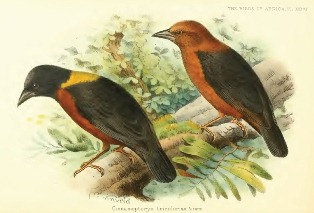
juvenile, figure from Shelley (1905) 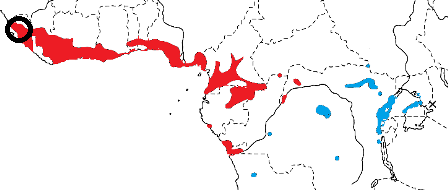
distribution, type locality circled IntroductionThe Yellow-mantled Weaver was formally described by Karel Johan Gustav Hartlaub, a German physician and ornithologist, but this species had been described previously.The Yellow-mantled Weaver was first described by George Robert Gray, an English zoologist, author, and head of the ornithological section of the British Museum. Gray started at the British Museum as Assistant Keeper of the Zoology Branch in 1831, when he would have found the specimen brought to the museum years earlier. Gray named the bird "Ploceus collaris" but this name had been used for the Village Weaver (now a subspecies), making the name invalid for the Yellow-mantled Weaver. The first person to realise this problem was Hartlaub, who renamed the specimen to its current name. The Yellow-mantled Weaver had been collected by Captain Edward Sabine, an Irish astronomer, geophysicist, ornithologist, explorer, and soldier. Sabine travelled halfway around the world to study the the "oblateness" (shape) of the Earth and carried out measurements on the intertropical coasts of Africa and the Americas. Sabine had struck up a friendship with Douglas Clavering, an officer of the British Royal Navy, who agreed to take Sabine on board the Pheasant. They travelled to Sierra Leone, the Island of St Thomas, Ascension Island, Bahia, Maranham, Trinidad, Jamaica, and New York during the years 1821-23. Sabine obtained the Yellow-mantled Weaver specimen while in Sierra Leone. The first illustration of a Yellow-mantled Weaver is by Reichenow (1902). The next illustration was published by Shelley (1905), including a juvenile. Reichenbach (1863) mentioned the species, and provided an English name (not the first English name, for once!), but did not illustrate it. Scientific citationHyphantornis tricolor Hartlaub 1854 Journ. f. Orn., 2, p.110 Sierra Leone.Meaning of namestricolor - Late Latin. tricolor, tricoloured, of three colours.First English nameYellow-collared Weaver (Gray 1831).Alternate namesYellow-collared Weaver, The tricoloured Weawer, Uganda Yellow-mantled Weaver.CollectorCaptain Edward Sabine.Date collectedBetween 1821 - 1823.Locality collectedSierra Leone.Type specimensThe type specimen is in the British Museum (Old Vellum Cat. 21 no. 81a). |
The above is based on Weaver Wednesday 2, a weekly series about the discovery of each weaver species.
This species text first appeared as
Weaver Wednesday [175] - Discovery [58]: Yellow-mantled Weaver on 2015-10-21
1. Basic biology
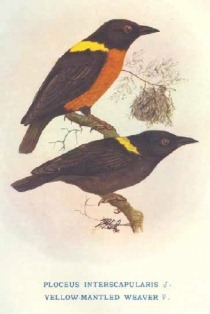
& female, from Someren 1913 
& juvenile, from Shelley 1905 Identification. The Yellow-mantled Weaver Ploceus tricolor has a striking plumage but is a quiet weaver of the forest canopy. It is black with a yellow hind-collar. The breast and belly are chestnut in the male and matt black in the female. The head of the juvenile is chestnut. Two other weaver species are similar in appearance. Subspecies castaneofuscus of Vieillot's Black Weaver, however, is noisy and active, has no yellow collar, and has a pale eye. The very rare Golden-naped Weaver has a yellow hind-collar but differs in having a yellow line down its back. Distribution.
The Yellow-mantled Weaver occurs from Sierra Leone to Uganda and south to northern Angola. It occurred in Kakamega Forest in western Kenya but there are no recent records. Two subspecies of the Yellow-mantled Weaver are recognised (see map below, based on Birds of Africa): Habitat. The Yellow-mantled Weaver inhabits the high forest canopy, particularly along rivers or near swamps. Food.
It feeds on insects, including grasshoppers, crickets, ants, caterpillars and butterflies, termite alates; small fruits and berries. It forages in foliage usually >25 m high, searching on small twigs, and also sallies above the canopy to hawk insects. The Yellow-mantled Weaver searches the bark of dead trees like a woodpecker, working up the tree trunk in an upright posture, and in a spiral direction. It flies to clusters of dead leaves in pursuit of insects trying to escape. Its dipping flight between trees is reminiscent of a woodpecker. It may be found in groups of 4-6 birds, and joins mixed-species flocks, especially at fruiting trees. It does not descend to the undergrowth, is usually silent, and thus easily overlooked.
Breeding. The Yellow-mantled Weaver is a monogamous, colonial nester, with up to 50 nests (average of 11, in 52 colonies in Liberia); one colony at Kumasi in Ghana contained about 500 nests. In mature forests in Liberia, 12 of 31 colonies were close to Palm-nut Vulture Gypohierax angolensis nests. The nest is a coarsely woven retort with a wide entrance tunnel. The nest is suspended at end of a thin bough at 20-50 m above the ground. The nest is constructed of rootlets, vine tendrils and fibres, and is lined with soft fibres. The eggs are white, almost translucent, or plain blue. The African Harrier Hawk Polyboroides typus is a major nest predator in Liberia. A colony in Ghana was destroyed by crows, harrier hawks and other raptors. The Yellow-mantled Weaver is parasitized by the Diederik Cuckoo Chrysococcyx capius. |
The above is based on Weaver Wednesday, a weekly series about weaver species.
This species text first appeared as
Weaver Wednesday [54]: Yellow-mantled Weaver on 2013-06-26
2. Breeding facts
| Pair bond Monogamous Breeding season Mar in Guinea, Oct in Liberia, Aug-Oct in Ghana, Oct-Mar in Nigeria, Sept-Mar in Gabon, Feb in Angola; in DRCongo, Jun-Oct in N, Jan-Jun in Kivu, Jun-Jul in C forest and Jan-Feb in Itombwe; May-Oct in Uganda Nest site suspended 20-50 m above ground (in Nigeria mean l6 m) at end of thin branch; in Gabon nests in same trees, often introduced cabbage-palm (Livistona australis) Nest building no information Colony size Colonial, with up to 50 nests together colonies in Liberia held average of 11 nests); one colony of 500 nests reported from Ghana Clutch size 2 eggs Egg colour white or plain blue Egg size size 23 x 1 6 mm Incubation no information on incubation period Chicks and nestling period no information on nestling period |
Breeding information based on Handbook of the Birds of the World, Vol. 15.
3. Photos of Weaver Nests
 Vm 13820 |  Vm 5873 |  Vm 5336 |
Thumb-nails of most recent PHOWN records - click on one to see its full record
See all PHOWN records for this species here.
PHOWN (Photos of Weaver Nests) provides valuable info on breeding distribution and colony sizes of weavers.
You can contribute by registering and submitting photos at Virtual Museum webpage.
4. Breeding distribution
Google map showing distribution (For species with small ranges you need to zoom in at the correct area to see the range):
yellow blob - range of weaver species; read more about this here.
![]() - PHOWN records with photos
- PHOWN records with photos
![]() - PHOWN records with no photos (Nest Record Cards, other records)
- PHOWN records with no photos (Nest Record Cards, other records)
![]() - Birdpix records
- Birdpix records
![]() - comments on out of range records, or interesting records
- comments on out of range records, or interesting records
![]() - type locality
- type locality
CLICK on the marker on the map to see individual record details.
5. Range changes
Not South African speciesThe above is based on Weaver Wednesday 3, a weekly series about range changes in South African weaver species.
This species text first appeared as
n/a








